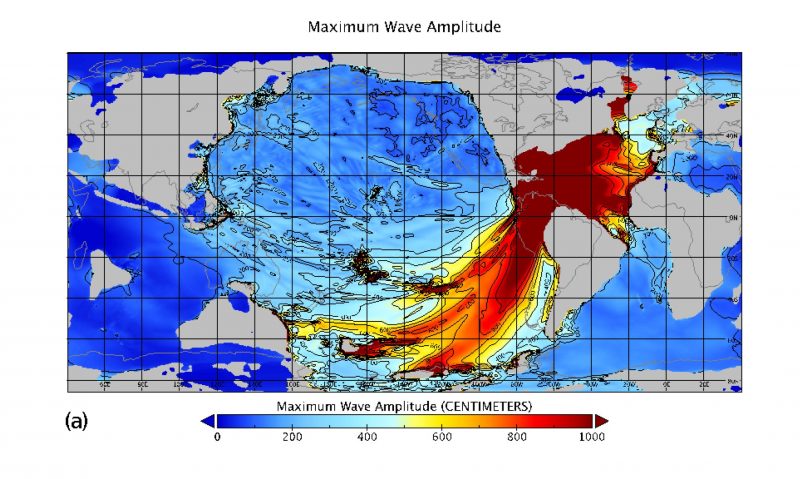Mighty wave from dino-killing asteroid
Oceanographers at the University of Michigan said on October 4, 2022, that the asteroid that struck Earth and wiped out the dinosaurs – 66 million years ago – also triggered a vast, global tsunami.
The great wave started out as more than a mile (1.6 km) high, they said. It was large enough to scour the ocean floor thousands of miles from the Chicxulub impact site on Mexico’s Yucatán Peninsula. And it took some days – “less than a week,” the scientists said – to dissipate. The authors calculated the initial energy contained in this ancient tsunami. And they found it was up to 30,000 times larger than the energy in the devastating December 2004 Indian Ocean earthquake tsunami, one of the largest tsunamis in the modern record. They said in a statement:
Any historically documented tsunamis pale in comparison with such global impact.
Their study is based on a combination of computer modeling and geological evidence. It published on October 4 in an open-access journal of the American Geophysical Union, called AGU Advances.
Strong evidence as far away as New Zealand
To cross-check their computer models with geologic evidence, the authors examined 120 geological sites and found evidence of a global tsunami, arriving as far away as what is now New Zealand. They compared those sediments to the waves and erosion predicted by their models. Lead author Molly Range, who worked as an oceanographer in the Ocean Modeling Lab at the University of Michigan from 2016 to 2020, explained:
This tsunami was strong enough to disturb and erode sediments in ocean basins halfway around the globe. It left either a gap in the sedimentary records or a jumble of older sediments. The distribution of the erosion and hiatuses that we observed in the uppermost Cretaceous marine sediments are consistent with our model results, which gives us more confidence in the model predictions.
The authors said that outcrops of the K-Pg boundary on the eastern shores of New Zealand’s North and South Islands are of special significance to their study. This area is more than 7,500 miles (12,000 km) from the Yucatán impact site. The heavily disturbed New Zealand sediments were originally thought to be the result of local tectonic activity. But given the age of the deposits and their location directly in the modeled pathway of the Chicxulub impact tsunami, the team suspected a different origin. Range explained:
We feel these deposits are recording the effects of the impact tsunami, and this is perhaps the most telling confirmation of the global significance of this event.

How much coastal flooding?
The authors said their study didn’t explicitly model coastal flooding. But, they said, wave heights could have approached more than 32.8 feet (10 meters) as the tsunami neared North Atlantic coastal regions and parts of South America’s Pacific coast.
As the tsunami neared those shorelines and encountered shallow bottom waters, wave heights would have increased dramatically through a process called shoaling. They said:
Such heights could well have caused substantial flooding, and some authors on this study will conduct a future study to explore that process.
Overall, according to the scientists’ statement, this study:
… presents the first global simulation of the Chicxulub impact tsunami to be published in a peer-reviewed scientific journal, corroborated by an exhaustive new compilation of geologic sites that hold evidence of a massive, global tsunami.
Bottom line: Evidence from both computer modeling and geologic sites suggests the dino-killing asteroid of 66 million years ago created a vast, global wave, with some 30,000 times the energy of the December 2004 Indian Ocean earthquake tsunami.
Source: The Chicxulub Impact Produced a Powerful Global Tsunami











